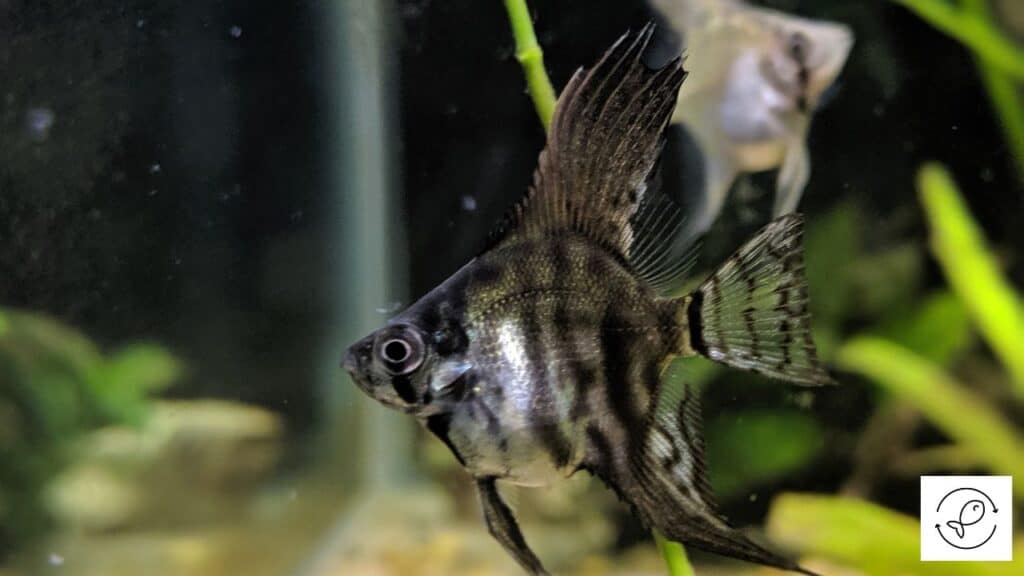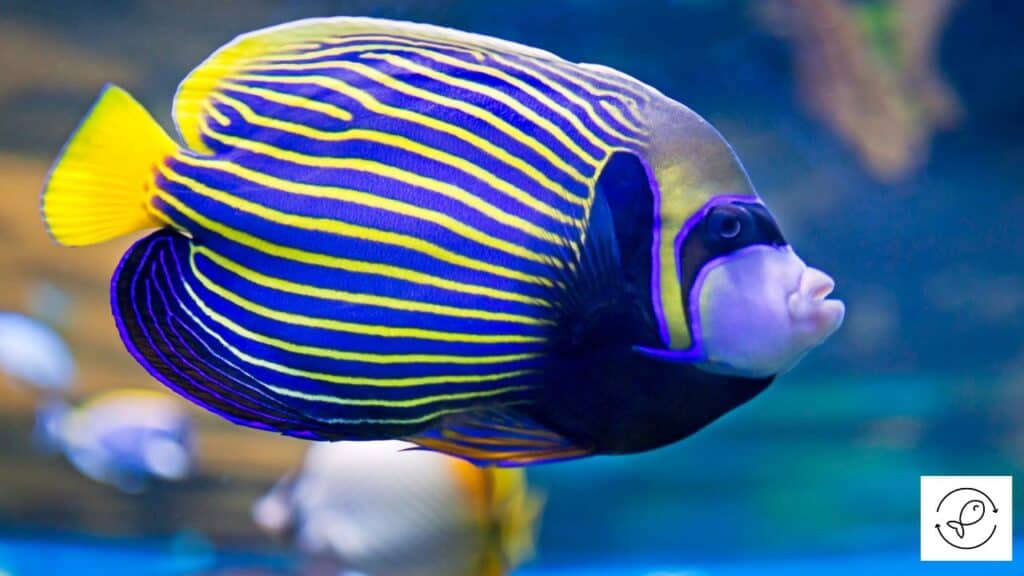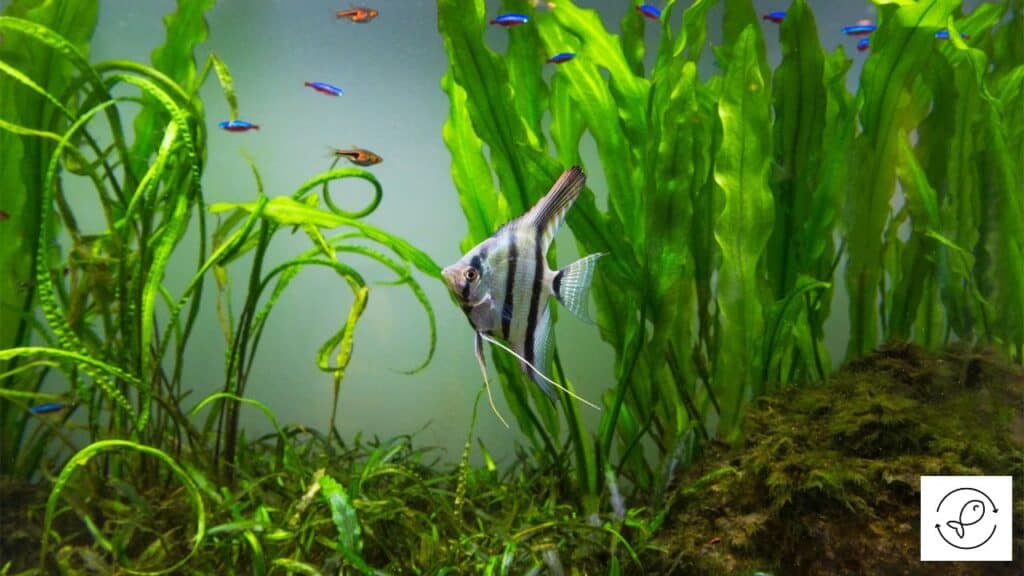Angelfish are freshwater as well as saltwater fish. Freshwater angelfish species belong to the Cichlidae family, whereas saltwater angelfish belong to the Pomacentridae family. These fish vary in size and shape, inhabit different environments, and have contrasting dietary requirements.
Let’s delve deeper into the numerous freshwater and marine angelfish species.
Freshwater Angelfish Species
Clown Angelfish
Clown angelfish display exciting colors and markings that stand out from other angelfish varieties.
Another peculiar feature of these fish is that no two clown angelfish look similar.
Their body is covered with patterns that make them look different from each other.
These shoaling cichlids are relatively docile and compatible with other peaceful fish as long as they have ample space in the tank.
Territoriality is usually at its peak during the spawning season among these angelfish.
Black Lace Angelfish
Black lace angelfish are a variation of zebra or silver angelfish with extra black genes.
As the name suggests, these fish are primarily black with flowing and lacy fins, making them look more attractive.
They grow up to 14 inches if they are taken care of properly in captivity.
These fish aren’t the most active swimmers and are susceptible to loud noises.
Half-Black Angelfish
Half-black angelfish, scientifically known as Pterophyllum Scalare, originate from the Orinoco Basin, Amazon Basin, and numerous rivers in the Guiana Shield of tropical South America.
These fish have half black and half white coloration. The front half of their body is silver, while the caudal part of the body is black.
They need a varied protein-rich meaty diet for healthy development.
You can occasionally feed them veggies twice a week to add variation to their diet.
Zebra Angelfish
Zebra angelfish, also known as Zebra lyretail, are a fish species in which males and females differ in appearance.
They are distinguished by four to six stripes on their body, including the stripe through the eye.
These fish are a little smaller than some of the other angelfish species and grow up to 10 inches in length.
However, they are active swimmers and faster than others.
Another unique feature is that some adult zebra angelfish develop red eyes.
It signifies full maturity and good health, though not all will develop the red eye.
Marble Angelfish
Marble angelfish are characterized by black and silver markings that are marbelized instead of the traditional stripes.
These fish are heavily or lightly marbled.
Marble angelfish are omnivores.
They feed on small fish, tiny crustaceans, insects, larvae, and other invertebrates that fits into their mouth.
A protein-rich diet is essential for their healthy development.
Marble Veil Angelfish
Marble veil angelfish are famous for their elegant fins and colorful patterns.
They have laterally compressed diamond-shaped bodies.
These fish need a tall aquarium as they grow up to 6 inches in length and 8 inches or more in height.
They prefer a planted tank with rocks, ample space for swimming, and subdued lighting.
Black Veil Angelfish
Black veil angelfish are medium-sized docile fish. They primarily inhabit the Amazon river basin of South America.
These fish have longer and more flowing fins than other angelfish species.
They are hardy and tolerate a wide range of pH values.
Black veil angelfish are slow-moving fish. So it’s essential to ensure that they get their share of food.
Albino Angelfish
Albino angelfish are silver or white in color with a yellowish-orange color ring around their eyes.
They are a perfect choice for aquarists who don’t like the typical bright colors of other angelfish species.
These fish are medium-sized, reaching a maximum of 6 inches in length.
Golden Angelfish
Golden angelfish are a unique fish as they appeared from a single spawning of black lace angelfish in the late 1960s.
These fish have long-flowing fins and are an absolute delight to watch while they swim.
They grow up to 6 inches long and 8 inches tall.
They thrive best in an aquarium with lots of plants, rocks, and slow-moving water.
Leopard Angelfish

The appearance and color of leopard angelfish resemble a leopard.
Natural spotted patterns that occurred in the wild angelfish were combined with captive-bred angelfish to produce an angelfish species with spots instead of stripes.
These fish need lighting as close as possible to their natural environment so that their spots keep dazzling.
Silver Angelfish
Silver angelfish are the most popular species in the aquarium trade.
These fish are moderately sized and grow up to 6 inches in length.
Their hardiness, beautiful coloration, and easy maintenance make them favorites among novice aquarists.
Silver angelfish prefer variety in their diet. A protein-rich diet is essential for their optimal growth.
You can feed them flakes, pellets, and live and frozen food in captivity.
Altum Angelfish
Altum angelfish are one of the largest angelfish species. They are an excellent addition to an aquarium if their needs are met.
Most of these fish have silver bodies with brownish-red bars. They have disc-shaped bodies and are very elegant.
Altum angelfish are highly sensitive and need specific tank conditions and a lot of care.
Although peaceful, they are timid and get frightened easily by fast movements.
Platinum Angelfish
Platinum angelfish stand out due to their dazzling platinum white patterns. They are easy-going fish that do well in community tanks.
Platinum angelfish are favorites among aquarists due to their beautiful colors and long flowing fins.
A decent-sized tank with ample space to move around freely, plenty of plant cover, and a nutritious diet is sufficient to keep them happy and healthy.
Smokey Angelfish
Smokey angelfish aren’t the most colorful.
They come in two varieties: the regular one, which is grey, and the chocolate type, which is brown.
These fish have patterns all over their body due to dark pigmentation.
The patterns aren’t symmetrical or identical and vary from black to grey coloration.
Smokey angelfish prefer a heavily planted aquarium with few driftwood and rocks to imitate their natural environment.
Koi Angelfish
Koi angelfish have been bred to resemble the coloration of Japanese koi fish.
They have a white body with black and orange or red patches.
These fish are similar to the gold marble variety but lack stripes.
The color of koi angelfish changes depending on their mood. The orange color gets darker when they are stressed.
Ghost Angelfish
Ghost angelfish are distinguished by their silver color with mostly no markings.
Occasionally, there are black spots on some of these fish.
Ghost angelfish have a genetic mutation that causes them to lose the stripes on their body, except their fins.
They don’t grow too big and reach up to 6 to 8 inches on maturity.
Blushing Angelfish
Blushing angelfish have round, laterally compressed, and diamond-shaped bodies.
They prefer a planted tank with rocks, subdued lighting, and an open area to swim freely and explore the surroundings.
These fish are omnivorous, feeding on tiny insect larvae in the wild.
In captivity, feed them flakes, pellets, and frozen or live food for healthy development.
Blushing angelfish are also docile and can be housed with similar-sized fish in a community aquarium.
Saltwater Angelfish Species
Flame Angelfish
Flame angelfish are the most sought-after marine angelfish species.
Their vibrant colors and gorgeous appearance make them popular among hobbyists.
These fish are bottom-dwellers that live on the slopes of coral reefs and lagoons.
Apart from being beautiful, flame angelfish are peaceful and easily cohabitate with other fish species.
Bicolor Angelfish
Bicolor angelfish are recognized by the yellow front half of their body, yellow tail, and blue patterns above and around their eyes.
These fish aren’t suitable for reef aquariums as they are shallow-water reef dwellers.
Instead, they are apt for medium to large community marine tanks.
Bicolor angelfish are very sensitive to even moderate fluctuations in water parameters and quality.
They need well-established tanks to thrive.
Keyhole Angelfish
Keyhole angelfish, also known as Melas or Tibicen angelfish, are one of the largest angelfish species.
These fish have a dark blue-black body with a contrasting white “keyhole” patch on their sides.
Keyhole angelfish aren’t reef-safe and are best suited in a live rock aquarium.
Black Nox Angelfish
As the name suggests, black nox angelfish primarily have a black body.
Their small size and peaceful nature make them attractive pets.
These fish aren’t fussy eaters and prefer a diet consisting of marine algae, spirulina, mysis shrimp, live rocks for grazing, and other meaty food.
Black nox angelfish aren’t best for reef aquariums as they tend to nip on corals.
French Angelfish
French angelfish are popular for their striking appearance. Young French angelfish primarily have black bodies with yellow stripes.
Their face turns grey once they mature, with their body remaining black.
These fish are hardy and less susceptible to diseases, making them ideal for a community tank.
Koran Angelfish
Koran angelfish inhabit the Indo-Pacific region.
These fish are also favorites among aquarists due to their hardiness and colorful appearance.
These fish need a large tank with ample hiding places and live rocks.
They aren’t suitable for reef tanks as they are known to nip at soft corals and clam mantles.
In captivity, feed koran angelfish a varied diet consisting of marine algae, spirulina, mysis shrimp, clams, shellfish, and other meaty products.
Annularis Angelfish
Annularis angelfish are called Blue Ring angelfish due to the blue ring near their head.
In the wild, they mainly feed on sponges, zooplankton, algae, nektonic fishes, and coral polyps.
In captivity, feed them prepared food containing sponge materials, nori flakes, mysis shrimp, etc.
Annularis angelfish are shy initially.
However, they get more aggressive toward tankmates as they grow, especially with other angelfish.
Goldflake Angelfish
Goldflake angelfish are one of the hardier and costlier angelfish species.
These fish are a sparkling beauty that light up any aquarium.
Goldflake angelfish need a large tank with ample hiding places like caves, rocks, and plants.
They also need open spaces for swimming and exploring the tank.
These angelfish are omnivorous and readily accept most foods, including live rock, frozen food, and prepared foods.
Bluegirdled Angelfish
Bluegirdled angelfish, also known as Majestic angelfish, are gorgeous. These fish primarily inhabit the Indo-Pacific region.
Bluegirdled angelfish mainly consume sponges and tunicates in the wild.
In captivity, feed them a mixture of vegetable-based food and meaty food such as shrimp, chopped squids, etc.
These fish are sensitive to the tank’s environment. Hence, tank hygiene and water parameters should be monitored closely.
Pearlscale Angelfish
Pearlscale angelfish, scientifically known as Centropyge vrolikii, is a marine ray-finned fish inhabiting the Indo-Pacific region.
These fish are oval-shaped with laterally compressed bodies.
In captivity, feed them a varied diet consisting of marine algae, spirulina, and other meaty products.
Live rocks are essential in their tanks as they like to graze on them.
Potter’s Pygmy Angelfish
Potter’s pygmy angelfish are very attractive.
They have bright orange coloration with vertical blue-to-black stripes on their bodies.
These fish are expensive as they are endemic to the Hawaiian Islands.
Potter’s pygmy angelfish need an established tank with ample swimming space and live rock structures.
Compatible tankmates and a well-balanced diet are crucial for keeping these fish happy.
Emperor Angelfish

Emperor angelfish are popular for their vivid coloration and beautiful markings.
These fish are found throughout the Indo-Pacific region.
Emperor angelfish are semi-aggressive. They prefer a spacious tank with plenty of hiding spaces and live rocks to graze on.
Feed them various foods, including prepared foods containing tunicates and marine sponges, vegetables, and live and frozen foods.
Scribbled Angelfish
Scribbled angelfish are one of the most attractive marine species.
They are favorites among aquarists for their striking colors and unique patterns.
These fish aren’t reef-safe as they nip on soft, stony corals and clam mantles.
They are hermaphroditic and hence are difficult to breed in captivity.
In captivity, feed scribbled angelfish a varied diet consisting of marine algae, spirulina, mysis shrimp, and other meaty products for optimum growth.
Bandit Angelfish
Bandit angelfish are endemic to the reefs in Hawaii and the Johnston Atoll.
These fish are difficult to feed in captivity as they primarily eat sponges in the wild.
Hence, you need to feed them prepared foods containing sponge as the main ingredient, along with spirulina, marine algae, and other meaty products.
Bandit angelfish thrive in large tanks with plenty of live rocks and open swimming spaces.
Lamarck’s Angelfish
Lamarck’s angelfish are one of the most dazzling and delicate-looking marine fish.
These fish are easy to keep and hardier, making them favorites among aquarists.
Lamarck’s angelfish are relatively peaceful and can be kept in small groups with one male and several females.
They are also reef-safe as they don’t bother the corals and other benthic invertebrates.
Rock Beauty Angelfish
Rock beauty angelfish are distinguished by their black bodies contrasted by a bright yellow tailfin and head.
Feeding adult rock beauty angelfish is challenging as they mainly rely on sponge material for nutrition.
Their young ones are easy to feed as they prefer more algal-type foods.
Peppermint Angelfish
Peppermint angelfish are one of the most expensive and exotic marine species.
These little gems are small-sized fish that grow up to 3 inches in length.
They are usually found in small groups or pairs in their natural environment to safeguard themselves from potential predators.
Young peppermint angelfish mainly consume small pieces of plant and animal matter in the wild.
On the other hand, adult peppermint angelfish feed on sponges, crustaceans, worms, and other organic matter.
Lemonpeel Angelfish
Lemonpeel angelfish is one of the most striking dwarf angelfish species that grow up to 5 inches in length.
These fish prefer a solitary life and gets aggressive when placed with other angelfish species.
Lemonpeel angelfish prefer a well-established tank with plenty of live rocks to graze on or an abundance of diatoms and macroalgae to feed on.
Red Stripe Angelfish
The red stripe angelfish is known by several names like Eibli angelfish, Orangelined angelfish, Eibl’s Dwarf Angel, and Blacktail angelfish.
These omnivores feed on benthic algae, hard coral polyps, and benthic seaweeds in their natural habitat.
They need a minimum of 70-gallon or larger tank with plenty of live rocks and hiding places to feel secure.
Coral Beauty Angelfish
Coral beauty angelfish is popular among aquarists for their small size and colorful appearance.
These fish are peaceful, hardy, and generally resistant to diseases.
They can be housed in a spacious community aquarium with similar-size and temperament fish and plenty of hiding spots.
The diet of coral beauty angelfish consists of marine algae, spirulina, meaty foods such as mysis shrimp, and other high-quality angelfish commercial foods.
Regal Angelfish
Regal angelfish are one of the most colorful and beautiful marine fish.
However, they are the most difficult to care for and are meant for seasoned aquarists.
These fish feed on sponges, tunicates, and benthic invertebrates in the wild.
Regal angelfish should be housed with compatible tankmates as they aren’t aggressive feeders and remain hungry if kept with fast-eating fish in a community tank.
King Angelfish
King angelfish inhabit the tropical reef areas neighboring Central America.
They primarily feed on sponges, invertebrates, algae, and plankton in the wild.
These fish are highly aggressive and best suited with similar temperament fish.
A large aquarium with ample swimming spaces, live rocks, and hiding places are essential to make them feel secure.
Queen Angelfish
Queen angelfish are graceful fish found in the coral reefs throughout the Western Atlantic Ocean.
These fish live in harems in their natural environment with a single male and multiple females.
Queen angelfish primarily consume sponges, marine invertebrates, tunicates, corals, bryozoans, jellyfish, algae, and plankton.
Gray Angelfish
Gray angelfish are one of the biggest angelfish species, reaching up to 24 inches in length on maturation.
These fish are highly aggressive and best when kept alone unless they are housed in a vast tank.
The minimum tank size needed for keeping these angelfish is 250 gallons or more, with plenty of live rocks to graze on and hiding places to rest.

